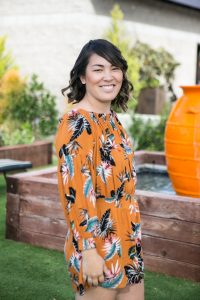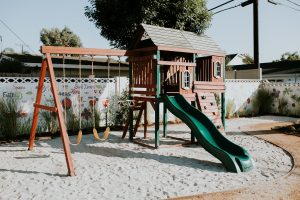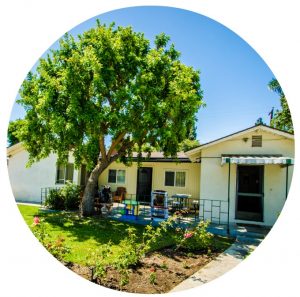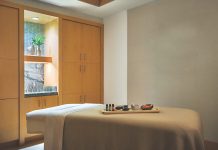
Newport Beach resident Jaana W. shares how her life has changed since overcoming addiction with the help of New Directions for Women.
By Ashley Ryan
After undergoing an intervention in her home state of Missouri and receiving treatment for opiate addiction on the East Coast, Jaana W. was in search of somewhere she could continue her rehabilitation without having to be apart from her then-2-year-old daughter. “There’s housing for women and children but in terms of treatment, where you can bring your child and receive good treatment, there’s not. It’s super rare,” Jaana says. “… Women are always the last ones to get help as well because they’re always taking care of something or someone else.”
Lack of options made her choice clear, so she traveled west, enrolling in treatment at New Directions for Women, a drug and alcohol rehabilitation and detoxification center in Costa Mesa near Upper Newport Bay; the organization celebrated its 40th anniversary this year. Since completing the program, Jaana has continued to be a part of the NDFW community, from speaking at alumni events to leading meditation for children. “In this world, it’s very loud and busy … and without taking a step back and looking at our relationships with people, places or things, we get lost in it very quickly,” she says.
Jaana currently serves as the director of admissions at The Chadwick House, a sober living home in Costa Mesa for women that she helped launch with longtime friend Brandon Stump following the success of The Ohio House, a sober living environment geared toward men that Stump founded five years earlier, also in Costa Mesa.
Jaana and her husband, Sam, now live in Newport Beach, where they are raising their three children and helping others who face the same struggles they once had to overcome.
How did you first become addicted?
My first time becoming addicted to anything was in high school, doing what, to my knowledge, was normal … [but it] isn’t normal looking back. … So addiction is a progressive disease. With that said, how did I get addicted? I had a C-section with my first daughter and I was prescribed pain medication. So, because it is progressive, you know, doing things in high school, it picked up in my early adulthood after I was prescribed pain medication … and kept getting prescribed.
What affect did it have on your life and your family?
Lost relationships, completely disconnected [from] life, unable to show up and be present … as a mother, as a wife, just as someone in a family. I wasn’t able to have a productive relationship because, at that point, when you’re addicted, drugs are more important than anything else.
Why did you decide to seek treatment?
I was fortunate enough to have an intervention and be presented with treatment. Initially, seeking treatment wasn’t a thought because I didn’t think it was possible given my situation—you know, being a mother, being a wife, being independent for so long. I didn’t think treatment would ever be an option for me.

What was the NDFW program like?
When I think of my time at New Directions, I think of being presented with opportunities and life challenges when it was necessary. The way it’s set up is it’s a transition … to where you learn how to bring your natural stressors into a controlled, supportive environment. When I specifically think of my time here though, I think of feeling safe, supported and encouraged to stay sober.
What was the hardest part of overcoming addiction?
Rebuilding my life. When you get sober, everything has to change. … Rebuilding my relationships, learning how to be independent again—you know, financially self-supporting, self-contributing into society. Starting over in California was extremely hard. It’s the most expensive place in America so it was very challenging. I mean, I lost everything in addiction … we were living with my in-laws, I had nothing.
In what ways has NDFW helped you?
The alumni community is very strong here so staying close and connected to the community is what’s helpful. [For] anyone who enters treatment … having that ongoing aftercare support is extremely vital. It offers accountability; it offers a continued community of women who are staying sober. That’s the ultimate goal. And things like this … they had a breakfast [fundraiser event] and I spoke at the breakfast. Being able to share my story and remember where I was at and get to be able to see how far I’ve come … it’s awesome.

How did you feel about being able to keep your daughter with you during treatment?
I remember sitting with my counselor and asking why there were so few places that I could bring my daughter to treatment, and I remember her saying, “Because at this point, they’ve usually lost their child.” And so … I feel extremely blessed and fortunate to have had that opportunity. It’s so important for a recovering addict as well as a mother to be able to have that child next to them when they’re going to sleep at night, being able to watch what they’re doing in day care, being able to give myself permission to take care of myself but yet being able to still be responsible as a mother. It’s what’s needed nowadays for a mother to continue to progress in sobriety.
How have you and your family been doing since you finished the program?
Amazing. I have three kids now. I work in the field so I get to share my experience, strength and hope daily with other women. I get to be a sober mother that’s present. Two of my kids have never seen me intoxicated, on anything. They just know me as a sober woman. … In the household, we’re very open and transparent with our emotions. … Because, with addiction, it’s a disease of perception and when you get sober you learn that a lot of how you were raised—you know, nurture versus nature—impacts your perception, your ability to have effective relationships. So for [my kids] right now, it’s just an open household, in terms of communication.
In what ways has your life changed since overcoming addiction?
It’s incredible, honestly. I have a very good life. I have a great job that I love. Being a mother—a sober mom that’s present—is the best thing to experience. There’s a lot of purpose in that. Having a healthy relationship with my husband, who’s also sober, and being able to support one another in our own recoveries is huge. I have great relationships with my families, the community—I love supporting New Directions and other nonprofits. I just live with purpose now.
Getting an Upgrade
New Directions for Women plans to remodel its Faith House, the family-style home where mothers receiving treatment are able to live with their children.
In 2001, New Directions for Women made an iconic move, offering family housing to women who were undergoing treatment and wished to have their children with them. “Women require specific elements in a treatment program to help them recover, including assistance with child care and parenting classes,” explains Tania Bhattacharyya, director of development and public relations.
Currently, these families live in Faith House, a more than 50-year-old building with three family-style bedrooms plus a common room and kitchen. NDFW plans to rebuild and expand Faith House to 11,000 square feet of residential treatment space, including a developmental child care facility and professional playground to replace the current Elliott House day care. The newly remodeled building will offer enough room for six families and will also house clinical spaces, executive offices and a boardroom as well as rose, vegetable and herb gardens.
NDFW hopes to complete the renovations within the next several years, depending on the donations the organization is able to raise. “We do have an anonymous family that has committed to matching every contribution dollar for dollar,” Bhattacharyya notes, “and we have also developed a campaign where donations for a commemorative paver or bench can be split up monthly over three years so everyone can have an impact on the building of this new space for women and children.”





